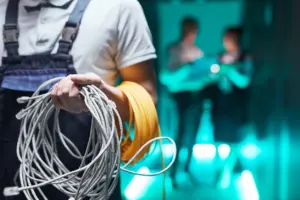How to Keep SCIF Room Conversations Private with Sound Masking
Is your SCIF really secure? Can you discuss classified information without risk of being overheard? Sound travels in a wave and, like water, looks for the areas of least resistance. The smallest opening allows sound to travel through it and potentially expose conversations, that should be secure and private, to be overheard. Precautions to maximize audible confidentiality do not need to be expensive, just implemented effectively.
What is a SCIF Room?
SCIF stands for Sensitive Compartmented Information Facilities and is typically designed and constructed for government or military facilities. SCIFs are secure facilities or areas for the transfer of sensitive and often classified information. The meaning or intention of a SCIF is complete confidentiality. A SCIF room should contain the transfer of information within with no leakage beyond its walls.
What are Some Common Issues with Military SCIFs?
SCIFs are designed to be secure and protected from outside unauthorized entry, as well as protect against data leaks of classified information. Furthermore, there are strict criteria, such as the DCID 6/9 Physical Security Standards for Sensitive Compartmented Information Facilities, to allow agencies to acoustically safeguard against exposure. And, as security measures are paramount with military SCIFs, there are points of concern in order to help protect speech confidentiality. These common vulnerabilities include:
- Air Ducts
- Plenum Spaces (the area between the ceiling and the deck above)
- Walls
- Windows
- Doors
Imagine the potential, devastating implications of a confidential or top-secret conversation being overheard outside of a military SCIF, especially if it involves national security. State-of-the-art technology can be used by outside groups or intelligence sources to listen into conversations through windows, walls, ducts, and any small opening where sound can escape. This is the necessity for a complete solution to prevent the escape of any sensitive information from the facility or space.
What Is Sound Masking?
Sound masking is the introduction of ambient noise, typically a blend of white and pink noise, to levels necessary to mask speech. Without getting too technical, sound masking uses specific frequencies that cover, or mask, human speech frequencies and therefore creates speech privacy. In other words, noise is introduced into the space, where the ears are, at a level above indirect speech levels rendering the conversation unintelligible.
Sound masking in the common application raises the ambient background sound to a level where the unintended listener is not distracted by the conversations around them. It is designed to increase productivity and comfort within the space. If interested, you can read about the difference between sound masking and white noise here.
How Sound Masking Maintains SCIF Privacy Better than Other Solutions
Unlike the common application, SCIFs require confidentiality, not just speech privacy. There is a difference. According to the American Society for Testing and Materials (ASTM), there are two methods of measurement:
- Articulation Index (AI) which measures how intelligible speech is; and,
- Privacy Index (PI) which measures the unintelligibility of speech
In essence, they are measuring the same thing. As you can see below, Normal Speech Privacy can be achieved when you can understand 20% or less of a conversation. This is the target for the more common applications, such as commercial office or healthcare environments. Confidential Speech Privacy, a requirement for SCIFs, is much more difficult to achieve. Confidential Speech Privacy requires that the listener can understand 5% or less of that conversation.

Understanding sound management in the industry is explained through the ABCs:
- A = Absorb. Absorptive materials, such as fabric panels, acoustical ceiling tile, partitions and carpet can help to minimize the reflection of sound.
- B = Block. Blocking noise is ensuring that sound cannot travel from one space to another. This is typically achieved by building walls from the floor all the way to the deck and ensuring that there aren’t any penetration areas such as ducts.
- C = Cover. Sound masking covers, or masks, speech by raising the ambient background sound above indirect speech levels – to a level of Normal or Confidential Speech Privacy.
Sound masking is not only cost effective (unlike blocking which adds significant construction dollars to a project), but it also adds benefits such as comfort and productivity to the space. Furthermore, utilization of sound masking products are effective in areas surrounding those confidential spaces – remember, masking goes where the ears are. It is also designed to be used in ductwork and on solid surfaces such as drywall and glass which helps in protection from the use of listening devices such as lasers (the vibration of solid surfaces disrupts the signal to the laser device).
Last, the Intelligence Community Directive (ICD) 705 helps to define the necessity for as many tools and resources in the construction process to achieve confidential privacy. This, along with DCID 6/9, help to ensure a successful implementation of military SCIFs.
Let Lencore Sound Masking Experts Help With Your SCIF
Sound masking is the introduction of subtle background noise into a space in order to make it confidential. Lencore sound masking systems produce a comfortable noise, blending white and pink frequencies, into the space at a level necessary for secure rooms to achieve Confidential Speech Privacy.
Lencore has helped thousands of clients and has millions of square feet installed around the world. Our experts can guide you through our process from sound masking selection to installation. We also understand the need for confidentiality and have signed numerous NDAs for undisclosed site locations and designs. Find more information to Lencore’s approach to sound masking in government facilties.
Furthermore, Lencore prides ourselves on the ease of doing business. By providing a simple floor plan and answer a few relevant design questions, Lencore will help guide you through the decision process. We provide options based on your space and do not constrain ourselves based on our system restrictions. We design what is right for your environment and can assist with installation, tuning and balancing through our expert, certified network. We will provide a quote and design layout – at no cost to you! We are happy to help.
Finally, if you would like to get a quick cost on what it would take for a sound masking system (equipment only), you can find it through our Quick Estimate Form. Or, if you are ready to go to the next level and plan out your sound masking system, you can Request a Quote, and we will provide all of the additional materials and details necessary to finalize your design.
Check Out Our Other Sound Masking Blogs

Maximize Your Investment: Integrate Paging into Your Sound Masking System
When a client starts planning for a sound masking system, they are usually focused on reducing distractions and improving speech privacy. But if you are already investing in a system that reaches every corner of your space,

Master Certified Installer Spotlight: Sean McGrath of Birkstone Services
When it comes to creating comfortable, private, and productive workspaces, sound masking has become a crucial part of modern building design. Few understand this better than Sean McGrath, owner of Birkstone Services, a structured cabling company with

White Noise vs Brown Noise vs Pink Noise
Every sound we hear is made up of frequencies, and not all noises are created equal. When comparing white noise vs brown noise vs pink noise, the difference lies in how each spreads its energy across the
